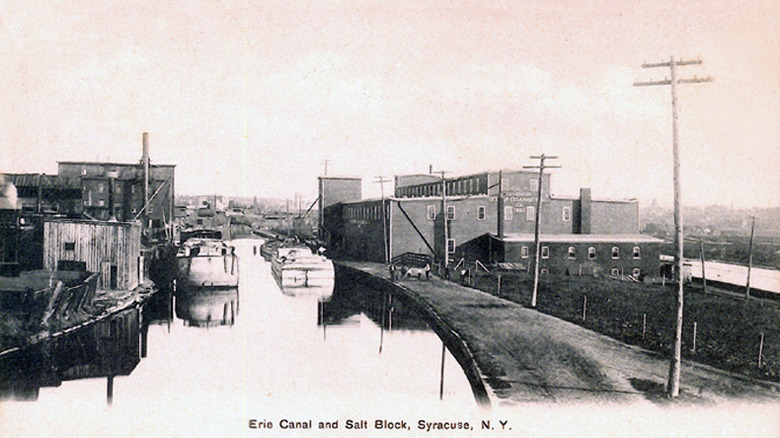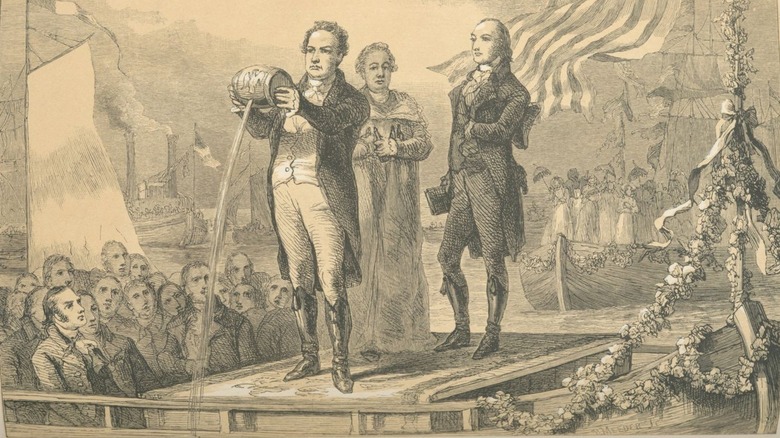Here's How The Erie Canal Was Built To Ease Transportation Through New York
When the original Erie Canal was built between 1817 and 1825, it was both the longest artificial waterway in North America and its most significant public works project. Since no one had ever accomplished such a monumental feat before, it also served as the country's first hands-on school of civil engineering.
The four-foot-deep and 40-foot-wide canal cut through 363 miles of land consisting of rivers, fields, forests, hills, rocky cliffs, and swamps between Albany and Buffalo. With a rise of 568 feet from the Hudson River to Lake Erie, engineers used 83 lift locks to navigate the hills. Eighteen aqueducts (an ancient Roman technology still in use today) were needed to move the canal over ravines and rivers. Seventeen toll booths and a 10-foot-wide towpath for animals ran the entire length of the canal. All for the low price of $7.1 million ($230 million today). The project was completed ahead of schedule and under budget. It was an immediate economic success, transforming the state of New York into the busiest port in the country and opening the continent's interior for what would become the Westward expansion.
Moving people and goods from the Hudson River area to the Great Lakes region by stagecoach or cart was a tedious and costly process. Shipping time between New York and Buffalo had previously been three weeks, but canal packet boats made the journey in just eight days. Meanwhile, the cost of shipping a ton of cargo between the two dropped from $100 to only $10. This allowed businesses of all types to sell their goods in areas they never dreamed possible.
From the Six Nations Indians to Jesse Hawley
The Erie Canal was only the latest and most technologically advanced version of a route that had long existed. The Hudson, Mohawk, and Oswego rivers, along with Wood Creek and Oneida Lake, were part of an ancient series of natural waterways used by the Six Nations Indians, including the Mohawk, Oneida, Onondaga, Cayuga, Seneca, and Tuscarora of the Haudenosaunee Confederacy for centuries.
In 1792, the "Inland Lock and Navigation Company" was formed to improve some of these natural waterways in upstate New York, and work lasted for several years. In 1807, a flour merchant named Jesse Hawley started writing essays from debtor's prison under the pseudonym "Hercules." Hawley had been forced into bankruptcy because he couldn't easily move his flour to a place where it could be sold. His essays, outlining the benefits of creating a man-made canal in the region, were published in the Genesee Messenger and are considered the earliest plans for what would become the Erie Canal (which is vastly different from the Welland Canal).
Hawley's essays were read by DeWitt Clinton – a state legislator, U.S. senator, and mayor of New York City – who became the canal's most ardent supporter. In 1808, Clinton was a member of the commission that oversaw the first surveys to lay out a plausible route for the canal. In 1816, he won preliminary approval for the canal and was appointed commissioner of the project. He was elected as New York's governor the following year and finally convinced the state legislature to authorize the $7 million loan to begin construction.
Governor Clinton's ditch was a smashing successs
Clinton broke ground at Rome, New York (considered the middle segment) on July 4, 1817. Construction on what was ridiculed and called by some "Clinton's Big Ditch" was divided into small sections and subcontracted to multiple contractors, each responsible for supplying their own equipment and work crews. In 1818, the labor force was 3,000 men, but by 1821, had grown to 9,000. Wages amounted to 50 cents a day ($12 a month), and only sometimes included food and boarding.
It took eight years using horses, picks, shovels, and other hand tools because neither dynamite nor the steam shovel had been invented yet. Engineer Canvass White created hydraulic cement that hardened underwater, reducing the time and cost of importing European cement. The first stretch from Utica to Salina (94 miles) opened in 1820. Another 250-mile section from Brockport to Albany and the Champlain Canal (from Lake Champlain to the Hudson) was opened in 1823.
Its completion was celebrated on October 26, 1825, a full two years ahead of schedule. After making the eight-day journey from Buffalo to New York City aboard the packet boat "Seneca Chief," Clinton ceremoniously poured water from Lake Erie into the Atlantic Ocean as a "marriage of the waters." In 1829, 3,640 bushels of wheat were being transported along the canal. By 1837, a staggering 500,000 were being moved, and by 1841, the number doubled to one million bushels. Within nine years, the cost of the canal's construction had been repaid through the collection of tolls.


